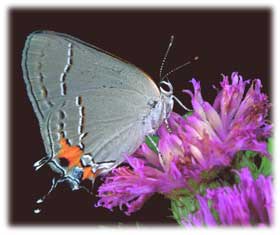

Often overlooked because of its small size, the gray hairstreak is a common butterfly of weedy, disturbed locations. It flies fast and erratic, and visits flowers frequently. Especially fond of composites, the gray hairstreak prefers a stable platform on which to land and easy access to the nectar in numerous short-tubed flowers like the disk florets in composite flowerheads. The gray hairstreak's wings below are light gray with two rows of black spots outlined in white. The upper wing surfaces are dark gray with a white fringe. Each hindwing bears a large bright orange patch and two hair-like tails. The sexes are similar, but females have wider and more rounded forewings.
The small green eggs are laid singly on the buds and flowers of some 200 different plant species in many different families. The young larvae feed on flowers and developing fruit, often boring into them. They are sometimes agricultural pests. Older larvae may feed on host plant leaves. The mature caterpillar is extremely variable but is usually unmarked reddish brown or green and covered with short hairs. It has a very small head. The pupa is light brown with numerous dark splotches. Several generations are produced each year.